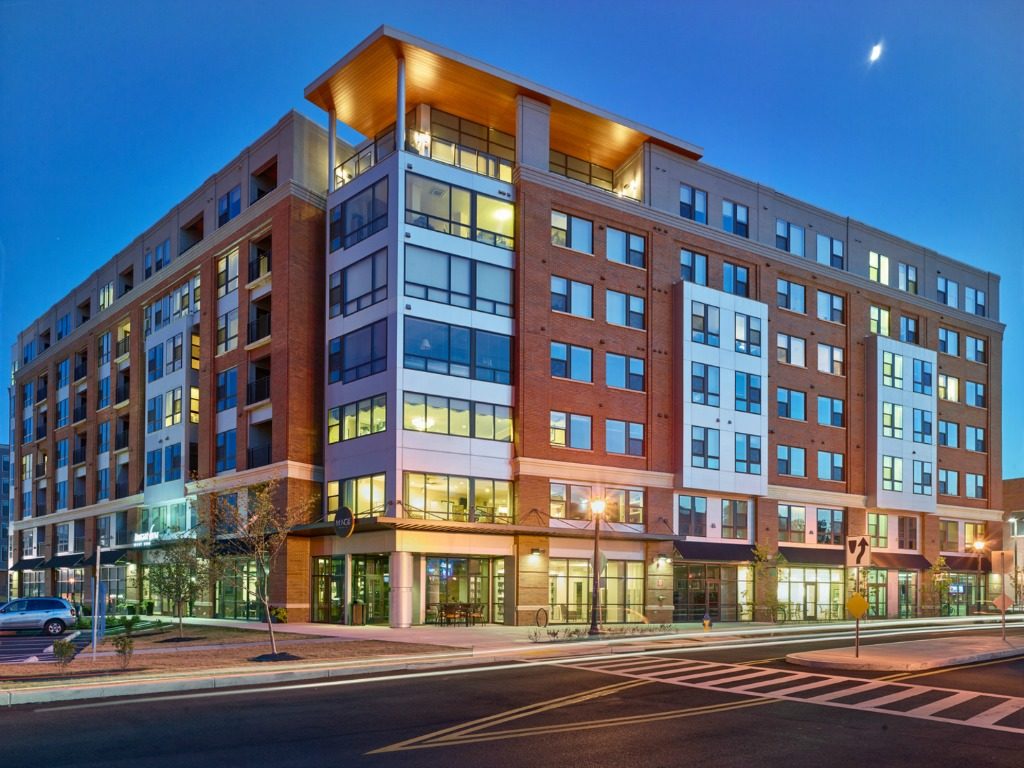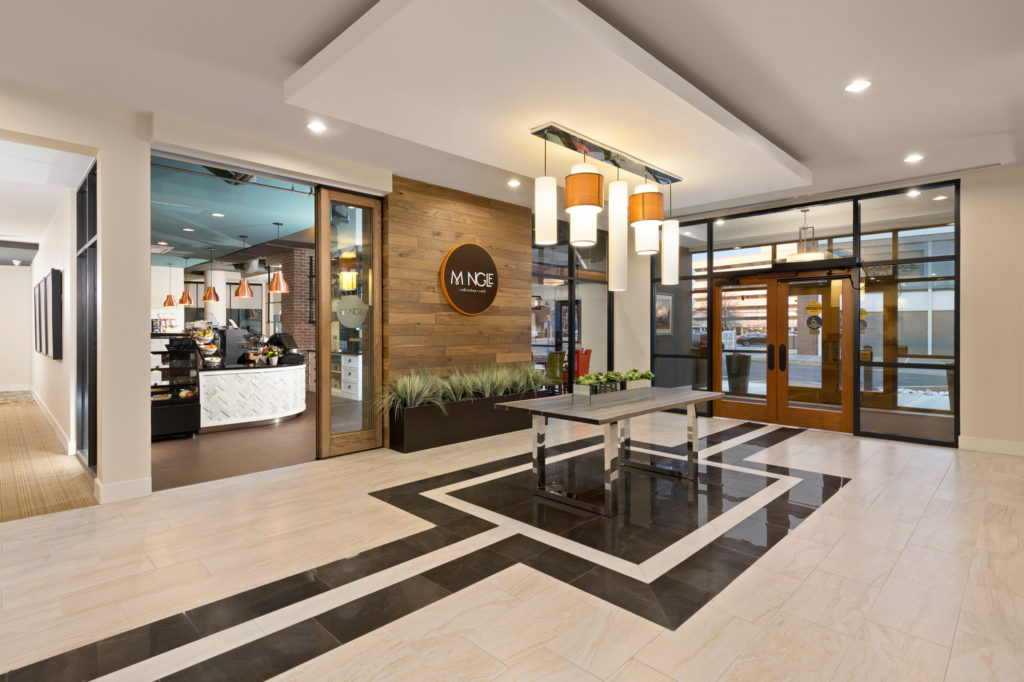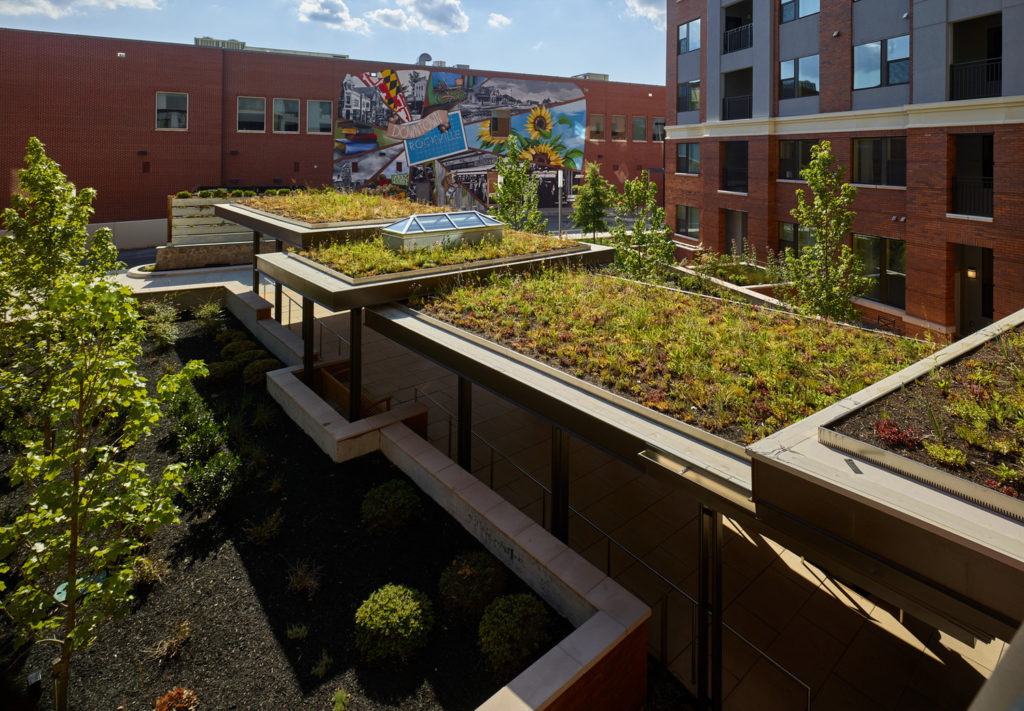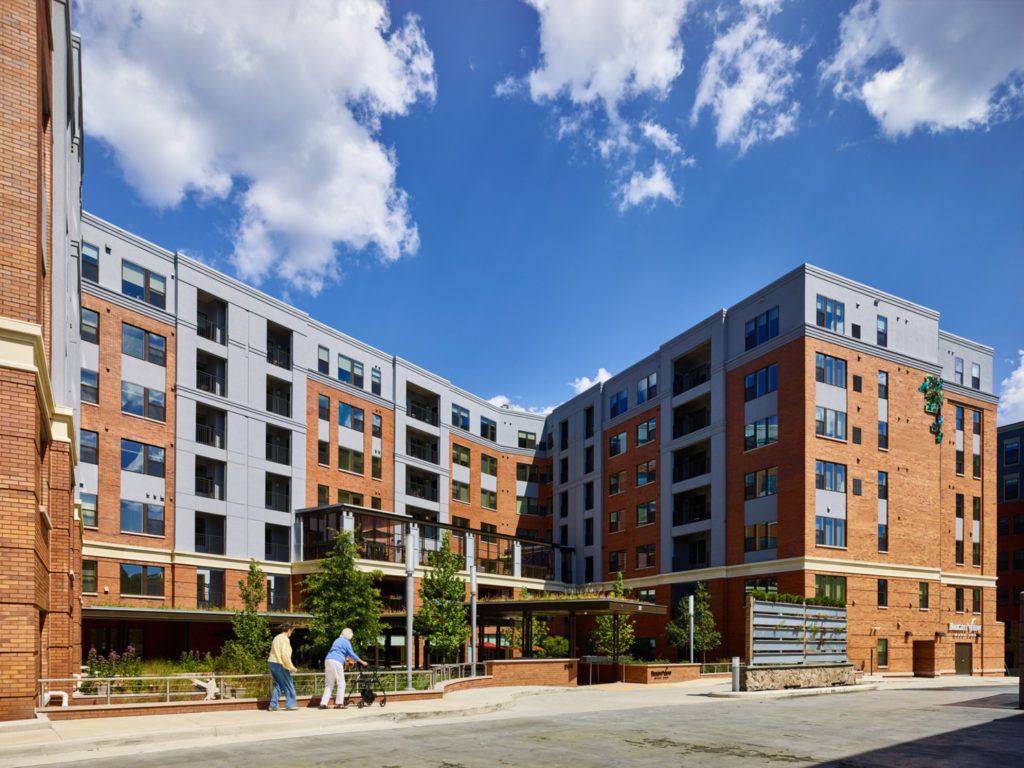Brightview Senior Living is growing at a steady clip — targeting mixed-use, urban development sites, entering new markets, and evolving its operating model to match its increased scale.
Since its founding in 1999, Brightview has made measured growth its mission, developing unique and forward-thinking urban properties such as Brightview West End in Rockville, Maryland, along the way. That community is part of a mixed-use development, and includes a six-story public mosaic called “The Tree of Life.” Similar projects are now in the works elsewhere, and the company is preparing to open its first Long Island location in Sayville, New York.
The Baltimore-based company owns and manages about 40 senior living communities in eight East Coast states. Brightview’s sister company is The Shelter Group, a real estate development and management firm.
To shed more light on Brightview’s approach to senior living, Senior Housing News caught up with the company’s CEO, Marilynn Duker.
The following interview has been edited for length and clarity.
SHN: You joined the company when it was The Shelter Group back in 1982. Tell me how you ended up there.
Duker: I was employee No. 1 when the company began.
Shelter was founded by Mark Joseph, who had a pipeline of a number of communities, all multifamily rental. And it was just getting to be too much to do with his law practice. He decided to hire somebody, we got together, and that was that. At the time, we didn’t have enough money for offices, so I sat in the back of the law firm for the first couple years until we started a management company and did our first couple of deals.
We started doing multifamily apartments, mostly in the suburbs around Baltimore, a mix of affordable and market rate. We had these three businesses, one capital-intensive and the other two more fee-driven.
We grew a large third-party property management business until the mid ‘90s. At that point, the tax-exempt bond company was getting ready to go public. And I never had any interest in being part of a public company. I really just always envisioned doing this with a couple of partners, and that was that.
We were incredibly fortunate to end up bringing Arnie Richman here, who is our chairman and my partner. Arnie really led the founding of Brightview. He had been a partner in Meridian Health Care, which was a large regional nursing home company that had sold to Genesis HealthCare in 1993. Arnie was looking around for what he was going to do next, and really wanted to be part of an operating company again. He came in late ‘95 and brought in this larger company operating experience and this understanding that senior living was an operating business, not a real estate business
And so Brightview grew from there?
This was the mid- to late-90s, so there was a lot of capital out there and a lot of interest in giving us capital when we had nothing. We had no assets and a small pipeline. I really credit Arnie with having the vision to say, let’s do this with high net worth individuals.
That’s how we did the first of seven funds, all high net worth individual investors, no institutional capital in our funds.
The first fund was only $5.8 million. It was people Mark and Arnie knew. Over time, we’ve had tremendous repeat investment at every fund along the way. Each fund has been larger than the last. I think one of the reasons we’ve been able to grow consistently, even through the Great Recession, is we’ve just had a lot of discipline around site and market selection and we have never had an aspiration to get to be a certain scale or a certain size.
That has meant big investments in the operating side, the home office infrastructure. Mostly people, but technology as well. We were consistently told we have an extremely high level of support for our communities from a home-office and regional standpoint, relative to our size, which I think is true. We’d love to make more money in our management company, but the real value is in the communities, and it’s just made sense to us, year after year, to continue to make that investment in that overhead, ahead of the growth coming online.
We grew very slowly in the early years, a mix of development and acquisitions, and in the early days, we went into a new market with acquisitions and then would start developing after that. But since 2009, we have not bought anything, and instead have focused on development. I think our operating people have a strong preference for that because we can build our culture from the ground-up and you have several years to plan for the opening of that community.
That’s essentially how we’ve grown. Our seventh fund was $200 million. We have about 300 investors in the fund.
I do think it’s interesting that one of the things you’ve seen, having been in this industry long, is how capital has viewed the sector. I credit NIC with a lot of this. Senior housing has gone from this very opportunistic investment that very few capital sources were doing to now being almost too ubiquitous, and there’s almost too much equity out there.
When Brightview started in 1999, did you ever see the industry growing into what it is now?
No.
We started off focusing, for the first couple of communities, on the traditional standalone assisted living and dementia care community. That is what our first community was. It had very limited common space and very small apartments relative to what you would see today and what we’re building today.
Our early communities had fairly low acuity, but they were a very different physical product than they are today. Labor was quite plentiful, which is certainly a big change from today. Obviously that is the industry’s No. 1 challenge now, and it’s certainly true for us in our markets.
We also had a strategy in the beginning of developing in secondary markets, and we even developed in a couple markets that we would not do today. We’ve greatly improved our data analysis around submarkets and we’re very data driven people as an organization. We just continued to refine that and get better and better at it.
Today we wouldn’t have developed in Westminster, Maryland, for example, which we did back then. We’ve gotten more focused increasingly on denser and denser markets. and we’re in great geography for that, from Virginia up to Boston.
We’ve also now started to do our first what I would call town center projects. They’re somewhat more urban. That’s increasingly where we think the market will be going as we all age. If we all think about where we’d like to live, it’s the Brightview West Ends.
That was a slick project. The public art component was very interesting.
It’s something the town of Rockville, Maryland, actually requires. We have a public art gallery in our other community in Rockville, as well. So, that whole concept of the art is something that we’re starting to adopt more broadly in our other communities, because you see the great benefit of it. Our senior vice president, Andrew Teeters … his daughter had painted one of the tiles on the outside of the building.
What’s your leadership style?
It’s such a team effort. We’re such a collaborative organization.
There are four of us that own the company now. One is Arnie. Jeff Hettleman is our chief financial officer, he’s been here 25 years, since 1994. And David Carliner is our partner who heads up our development company, and he’s been here since 2003.
We work exceptionally well together. We just have tremendous respect for one another. We all add value in different ways. We’ve tried to have a relatively flat organization and involve a lot of different people in decision-making. We’re certainly not perfect at that, and we’re always trying to get better at that. It’s very rare to see a decision get made about something that impacts a community just by people in the home office.
We also involve people from the community in those decisions. There’s tremendous benefit from the input of our directors and our frontline associates in the community. We really try and have a view that we’re all one Brightview. That’s one of the great benefits of the sale we did in 2017 of our affordable portfolio. The whole idea there was it had become an increasingly small part of our portfolio, relative to Brightview, and it was getting tough to do deals there that we felt matched our risk profile. Jeff actually led the sale of that business, and it’s really allowed us to focus all of our attention on Brightview.
The home office is really there to support the communities, not the other way around. Even our development company is exceptional at continuously learning from and incorporating operations in the upfront design and development process.
How do you support those communities from the home office?
We have a post-opening process, where at three, six, nine and 12 months, our development team goes out to the community and meets with the team there. And at 12 months, they do focus groups with residents, family members and frontline associates, to say, ‘You’ve lived at the building for a year now, tell us what works and what doesn’t work.’
When we go to a community, it’s not, ‘Uh oh, here comes the home office, why are they coming to visit me?’ It’s just a perfectly natural thing, and it’s an opportunity to hear from them and share information with them.
We get really great scores on our associate engagement, and regardless, what we aim for is year-over-year continuous improvement. Even the best communities do an action plan for their lowest scoring items and how can they improve those.
We do town halls twice a year where people can ask us anything. We have a once-a-month staff meeting that is intended to be both a communication tool and also for information sharing. We have a great meeting coming up in June called the Resident Experience, where we have an independent living resident, an assisted living resident, and a family member of Wellspring Village, which is our dementia program, come to the staff meeting and each talk a little bit about how they got to Brightview and what their experience has been. And the home office team can ask them questions. It’s my favorite meeting of the year.
You’ve got to hear from people and not sit in your office and think you know everything.
One of the things we’ve most recently tried to focus on is making sure this company can go on long beyond the day-to-day involvement of all of us. So that it’s not a creature of four or five of us. It’s really a mission-driven organization that’s here to stay and will be around for the long-term.
We’re very sensitive to not have that big company mentality and have people feel we’re tying their hands and making it difficult for them to do what’s best for their residents.
How are you planning for the long-term success of Brightview?
We started focusing on longer-term succession planning several years ago.
We did a national search for a president, which was then my title. And we deliberately looked at people from outside the industry because we’ve had a great track record here of bringing people in from the outside.
We were very fortunate to find Doug Dollenberg, our president, through a mutual friend. He came from wireless technology, but he’s just been the perfect cultural fit, which we were looking for. Cultural fit, leadership experience and long-term potential.
He spent four full months out in the community. He went to every single community, he shadowed every frontline position. So he understood and got to meet and hear from all of our different frontline positions about what their job is like, what the challenges are. He traveled with all of the senior leaders as well as every regional director so that he saw communities through their eyes.
He came back and said, we need to do more to support the communities on recruiting. It was a valuable observation that, when you’ve been here as long as I have, there’s benefits of that, but there’s also a risk you keep doing the same thing for too long. So, it’s been very valuable to have him here and have a fresh set of eyes.
In addition to that, we have a next generation of leadership in all parts of the business that we’re very focused on developing, both on individual development plans, but also we’ve made a substantial commitment this year to a leadership institute at UMBC, the University of Maryland Baltimore County.
We have close to 100 people from throughout the company going through it. It’s a very robust program that includes 360-degree reviews, some coaching, a phenomenal instructor. We’re very excited about that. It’s just part of what we’re doing to really develop our next generation of leaders in the business.
Let’s go back to the town center projects like West End that you’re favoring. What’s appealing about those kind of projects?
The penetration rate of people that can afford and need our services is something like 12% or 15%. If we could even increase that a percent or two by attracting a different group of people that’s not choosing senior living, that would be great, and it would be huge for the industry. We think there are people out there who want this model and that’s certainly proving to be the case.
In addition to West End, we opened in Wakefield, Massachusetts, about a year ago, and that was a community where we knew four new assisted living and dementia care standalone communities were coming into that market right around the same time. But it’s been a home run, one of our faster fills.
It’s right on the main street of downtown Wakefield, a typical New England town. Residents can walk to the restaurant and the bank and the dry cleaner. That’s just very appealing for people. You don’t have to find all your activity right there at the community.
We just think it helps expand the market and is increasingly what the customer of the future will want, or at least a sizable segment of it.
Is it more costly to develop this way?
It definitely is more costly.
We’ve done a lot of thinking about finding the places in which we can command the rates to offset that higher cost. We’ve done some focus groups and some research with real potential residents to understand these tradeoffs, and whether people really are willing to pay more for that kind of environment. Today, I think it’s a select number of places where one can do that and command those higher rates. We’re certainly still building our more typical three- or four-story Brightview, but we’re definitely looking for these opportunities.
We all know labor markets are really tight, and wages are going up. How concerned are you about staffing, and are there any initiatives at Brightview focused on hiring and retention?
We have made this a major focus, retention and recruiting, for several years now.
It’s everything from our senior vice of operations, Brian Engle, and his analyst, [who] went out and interviewed numerous directors and frontline associates at various communities and examined why they stay, what they like about Brightview and why they think people leave. They did a lot of data analysis, as well, but this qualitative analysis was enormously valuable.
One of the big challenges is scheduling. One of our associates has spent the better part of last year and this year rolling out, testing, piloting, evaluating, learning and then finally rolling out new company-wide scheduling software that we think will really help. But that software alone isn’t the solution. There’s got to be training, and then you’ve got to set standards around it.
There’s new software now, AI software that looks at who will stay in a company.
Is this Arena?
Yes. We’re doing a pilot with them. On retention, we only had 8% executive director turnover last year, which was really terrific. We’re on a seven-year trend of increasing associate engagement and a seven-year trend of declining turnover.
I think this is true for everyone in this industry, but your highest turnover is your part-time staff. Our economic model demands that you have a decent percentage of part-time associates. The main reason they leave is, they want more hours or they want a full-time job. And so if we can create more avenues through which they can understand that hours are available … or that there’s a full-time job at that other community, that’s good for us and it’s good for them.
Our greatest turnover was in our first year, and most of that was in the first 90 days. This was several years ago when we did this analysis. So, that tells you, is your selection process where it should be? What are you doing about onboarding and training? We did a lot to revamp those things.
We have a frontline assessment tool we use for all frontline associates. Once we focused on that, that was something we expect everyone to comply with and use. One of the great benefits of it is that it generates a candidate-specific set of interview questions so that if you have a maintenance director that is hiring a housekeeper but might only hire one or two a year, he may not be a highly skilled interviewer. So, this is giving him tools that are behavior-based questions.
We’ve seen evidence that construction starts are slowing, though it’s still early to make a clear determination. Are you seeing that too? Where do you think we are in the supply cycle, and how is that playing into your plans for development?
We’re not seeing a construction slowdown in our markets. Definitely not. We’re still seeing a lot of pressure on pricing. A lot of that is driven by construction labor.
On the supply side, we’ve seen the same data. I think there’s still a fair amount of pipeline coming that we’re aware of in our markets. To date, it has not been too much supply because of the density and the wealth of these markets. We still feel really good about these markets in the long-term. There can be some near-term pressure, but in the long-run there’s just plenty of demand in our markets.
It will be really interesting to see what happens, though, if the economy slows down, what the banks do. Because they have been the constraint to-date. And they could start to be a much larger constraint if there’s a slowdown.
What are some other current priorities for Brightview?
Innovation is one.
Andrew Teeters is leading a group on product innovation, and by that I mean both physical product and the operating model. He’s really trying to look at the customer of the future, not 25 years from now, but the next 5 to 10 to 15 years, and what we can do now to start to innovate and be as flexible as possible.
We’re always dealing with this issue of standardization versus empowerment. When you’re a company our size, it’s right at our size when that starts to hit you. And you have to make decisions about what are you going to standardize and say, if you’re a Brightview, this is the way you do X, Y or Z, versus how much you empower the teams in our community to make decisions about X, Y or Z.
We definitely favor the empowerment over the standardization. There are certain areas that lend themselves to standardization, like business office practices. Recruiting is actually another one, as is orienting new residents to the community. We have a program for new residents called Flourishing at Brightview. We think there’s tremendous value in residents getting oriented appropriately to the community.
When it comes to dining, we have minimum standards that we expect every community to follow, but there’s tremendous opportunity to innovate and be creative in your market and we believe those things are part of what attracts people to come and work for us.
The last communities we acquired, I won’t say who they were operated by, but that company had a particular style of operations where everything was dictated from the home office. When we went in and explained to the team at the community that was not our approach and we expect them to act in the best interests of the residents and make their own decisions, people said, ‘oh yeah, we would love that, that would be great,’but they were working in that particular style of company for a reason in most cases.
In the long run, some of those associates stayed with us and were able to work in our system, but many were not. It takes a certain kind of person to operate in that environment. and it’s not as highly structured as some other companies or businesses might be.
We’re very sensitive to not have that big company mentality and have people feel we’re tying their hands and making it difficult for them to do what’s best for their residents.








